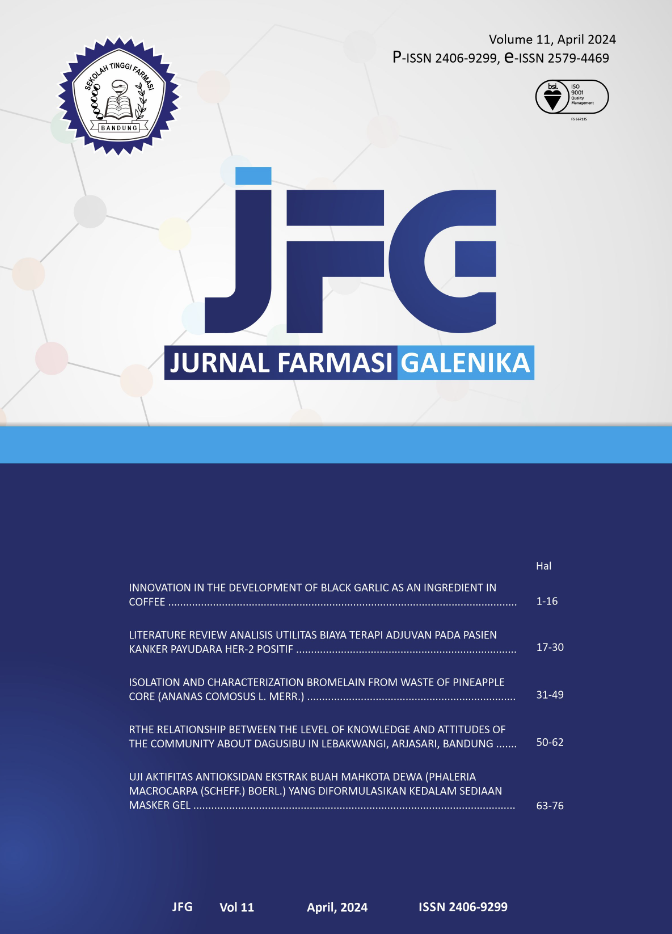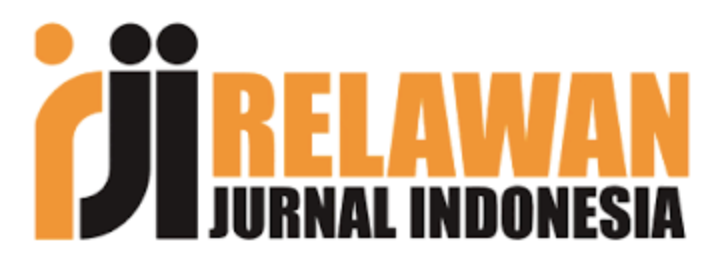Literature Review Analisis Utilitas Biaya Terapi Adjuvan pada Pasien Kanker Payudara HER-2 Positif
DOI:
https://doi.org/10.70410/jfg.v11i1.326Abstract
Breast cancer is one of the diseases that causes death in women in the world. The high costs incurred to control cancer can affect the control of other diseases. One of the therapies given to breast cancer patients is adjuvant therapy. This review article aims to determine the cost utility of adjuvant therapy in Human Epidermal Growth Factor Receptor-2 (HER-2) Positive breast cancer patients in various countries. The article review method used is a literature review by conducting a literature study using the Pubmed and Google Scholar data bases. After conducting a literature study, 37 articles were obtained but only 4 articles met the inclusion and exclusion criteria. The articles used are articles that discuss the comparison of cost-effectiveness with quality of life as a clinical outcome of adjuvant therapy used by HER-2 Positive breast cancer patients. The articles used were conducted in 4 countries, namely the United States, Japan, the Philippines and Brazil. The results of the review of each article used show that each country has different strategies regarding costs for providing adjuvant therapy to HER-2 Positive breast cancer patients. The use of adjuvant therapy with the highest total costs, namely trastuzumab emtansine (T-DM1) in the United States (USD 218,179.98). The highest ICER value in this review article is a comparison of trastuzumab alone with the combination trastuzumab-neratinib (USD 416,106) in the United States. The therapy that produced the highest clinical outcome value of quality of life was T-DM1 (17,310) in Brazil and the United States. There is a comparison of the total cost and effectiveness of adjuvant therapy for HER-2 positive breast cancer. Differences in total costs and cost-effectiveness are influenced by research time, population, policies related to determining minimum treatment costs, currency, and research methods.
Downloads
References
Bray, F. et al. (2018) ‘Global cancer statistics 2018: GLOBOCAN estimates of incidence and mortality worldwide for 36 cancers in 185 countries’, CA: A Cancer Journal for Clinicians, 68(6), pp. 394–424. Available at: https://doi.org/10.3322/caac.21492.
Colleoni, M. et al. (2015) ‘Adjuvant Exemestane with Ovarian Suppression in Premenopausal Breast Cancer’, 371(2), pp. 107–118. Available at: https://doi.org/10.1056/NEJMoa1404037.Adjuvant.
Cuschieri, S. (2019) ‘The STROBE guidelines’, Saudi Journal of Anaesthesia, 13(5), pp. S31–S34. Available at: https://doi.org/10.4103/sja.SJA_543_18.
Dipiro, J.T. et al. (2015) Pharmacoterapy A Phatophysiologic Approach, United State: McGraw-Hill Education.
Donepudi, M.S. et al. (2014) ‘Breast cancer statistics and markers.’, Journal of cancer research and therapeutics, 10(3), pp. 506–511. Available at: https://doi.org/10.4103/0973-1482.137927.
Genuino, A.J. et al. (2019) ‘Cost-utility analysis of adjuvant trastuzumab therapy for HER2-positive early-stage breast cancer in the Philippines’, BMC Health Services Research, 19(1), pp. 1–12. Available at: https://doi.org/10.1186/s12913-019-4715-8.
Jia, Z. et al. (2019) ‘Critical review of volatile organic compound analysis in breath and in vitro cell culture for detection of lung cancer’, Metabolites, 9(3). Available at: https://doi.org/10.3390/metabo9030052.
Kementerian Kesehatan Republik Indonesia (2013) Pedoman Penerapan Kajian Farmakoekonomi. Jakarta: Kementerian Kesehatan Republik Indonesia.
Kementerian Kesehatan RI (2013) Pedoman Penerapan Kajian Farmakoekonomi. Jakarta: Kementerian Kesehatan RI.
Kementerian Kesehatan RI (2014) Panduan penatalaksanaan kanker payudara, Kementerian Kesehatan RI. Jakarta.
Kementerian Kesehatan RI (2018) Keputusan Menteri Kesehatan Republik Indonesia Nomor Hk.01.07/Menkes/414/2018 Tentang Pedoman Nasional Pelayanan Kedokteran Tata Laksana Kanker Payudara, Kementerian Kesehatan RI. Jakarta. Available at: http://dx.doi.org/10.1186/s13662-017-1121-6%0Ahttps://doi.org/10.1007/s41980-018-0101-2%0Ahttps://doi.org/10.1016/j.cnsns.2018.04.019%0Ahttps://doi.org/10.1016/j.cam.2017.10.014%0Ahttp://dx.doi.org/10.1016/j.apm.2011.07.041%0Ahttp://arxiv.org/abs/1502.020.
Lao, C. et al. (2022) ‘Differences in Breast Cancer Costs by Cancer Stage and Biomarker Subtype in New Zealand’, PharmacoEconomics - Open, 6(4), pp. 539–548. Available at: https://doi.org/10.1007/s41669-022-00327-5.
?ukasiewicz, S. et al. (2021) ‘Breast cancer—epidemiology, risk factors, classification, prognostic markers, and current treatment strategies—An updated review’, Cancers, 13(17), pp. 1–30. Available at: https://doi.org/10.3390/cancers13174287.
Magalhães Filho, M.A.F. et al. (2022) ‘Cost-effectiveness analysis of Ado-trastuzumab emtansine for the treatment of residual invasive HER2-positive breast cancer’, Einstein (Sao Paulo, Brazil), 20(4), p. eGS6655. Available at: https://doi.org/10.31744/einstein_journal/2022GS6655.
Matkowski, R., B?aszczyk, J. and B?aszczyk, D. (2020) ‘Does Breast Cancer Increasingly A ff ect Younger Women??’, pp. 1–10.
von Minckwitz, G. et al. (2017) ‘Adjuvant Pertuzumab and Trastuzumab in Early HER2-Positive Breast Cancer’, New England Journal of Medicine, 377(2), pp. 122–131. Available at: https://doi.org/10.1056/nejmoa1703643.
von Minckwitz, G. et al. (2019) ‘Trastuzumab Emtansine for Residual Invasive HER2-Positive Breast Cancer’, New England Journal of Medicine, 380(7), pp. 617–628. Available at: https://doi.org/10.1056/nejmoa1814017.
Nurmainah, N., Syabriyantini, S. and Susanti, R. (2017) ‘Efektivitas Biaya Penggunaan Ampisilin Dansefotaksim Pada Pasien Anak Demam Tifoid’, Media Kesehatan Masyarakat Indonesia, 13(2), p. 131. Available at: https://doi.org/10.30597/mkmi.v13i2.1984.
Shidqi, Z.N. et al. (2022) ‘Faktor-Faktor Keterlambatan Diagnosis Kanker pada Pasien Kanker Payudara: Systematic Review’, 7(2), pp. 471–481.
Shien, T. and Iwata, H. (2020) ‘Adjuvant and neoadjuvant therapy for breast cancer’, Japanese Journal of Clinical Oncology, 50(3), pp. 225–229. Available at: https://doi.org/10.1093/jjco/hyz213.
Siegel, R.L., Miller, K.D. and Jemal, A. (2018) ‘Cancer statistics, 2018’, CA: A Cancer Journal for Clinicians, 68(1), pp. 7–30. Available at: https://doi.org/10.3322/caac.21442.
Silva, C. et al. (2019) Breast cancer metabolomics: From analytical platforms to multivariate data analysis. A review, Metabolites. Available at: https://doi.org/10.3390/metabo9050102.
Sung, H. et al. (2021) ‘Global Cancer Statistics 2020: GLOBOCAN Estimates of Incidence and Mortality Worldwide for 36 Cancers in 185 Countries’, CA: A Cancer Journal for Clinicians, 71(3), pp. 209–249. Available at: https://doi.org/10.3322/caac.21660.
Takumoto, Y. et al. (2022) ‘Cost-Effectiveness of Trastuzumab With or Without Chemotherapy as Adjuvant Therapy in HER2-Positive Elderly Breast Cancer Patients: A Randomized, Open-Label Clinical Trial, the RESPECT Trial’, Clinical Drug Investigation, 42(3), pp. 253–262. Available at: https://doi.org/10.1007/s40261-022-01124-y.
Tran, P.T. and Diaby, V. (2020) ‘Cost-effectiveness analysis of adjuvant neratinib following trastuzumab in early-stage HER2-positive breast cancer’, Journal of Managed Care and Specialty Pharmacy, 26(2), p. 221. Available at: https://doi.org/10.18553/jmcp.2020.26.2.221.
Vivekanandhan, S. and Knutson, K.L. (2022) ‘Resistance to Trastuzumab’, Cancers, 14(20). Available at: https://doi.org/10.3390/cancers14205115.
Word Health Organization (2020) Global Cancer Observatory: Cancer Today. Lyon: International Agency for Research on Cancer; 2020. Available at: https://gco.iarc.fr/today (Accessed: 22 August 2023).
Word Health Organization (2022) Cancer, Word Health Organization. Available at: http://www.who.int/news-room/fact-sheets/detail/cancer (Accessed: 22 August 2023).
Xuhong, J.-C. et al. (2019) ‘Mechanism, safety and efficacy of three tyrosine kinase inhibitors lapatinib, neratinib and pyrotinib in HER2-positive breast cancer.’, American journal of cancer research, 9(10), pp. 2103–2119. Available at: http://www.ncbi.nlm.nih.gov/pubmed/31720077%0Ahttp://www.pubmedcentral.nih.gov/articlerender.fcgi?artid=PMC6834479.
Downloads
Published
How to Cite
Issue
Section
Citation Check
License
Authors who publish in Jurnal Farmasi Galenika agree to the following terms:
This license enables reusers to distribute, remix, adapt, and build upon the material in any medium or format, so long as attribution is given to the creator. The license allows for commercial use. CC BY includes the following elements:
BY: credit must be given to the creator.
You are free to:
- Share — copy and redistribute the material in any medium or format for any purpose, even commercially.
- Adapt — remix, transform, and build upon the material for any purpose, even commercially.
- The licensor cannot revoke these freedoms as long as you follow the license terms.
Under the following terms:
- Attribution — You must give appropriate credit , provide a link to the license, and indicate if changes were made . You may do so in any reasonable manner, but not in any way that suggests the licensor endorses you or your use.
- No additional restrictions — You may not apply legal terms or technological measures that legally restrict others from doing anything the license permits.
Notices:
You do not have to comply with the license for elements of the material in the public domain or where your use is permitted by an applicable exception or limitation .
No warranties are given. The license may not give you all of the permissions necessary for your intended use. For example, other rights such as publicity, privacy, or moral rights may limit how you use the material.










